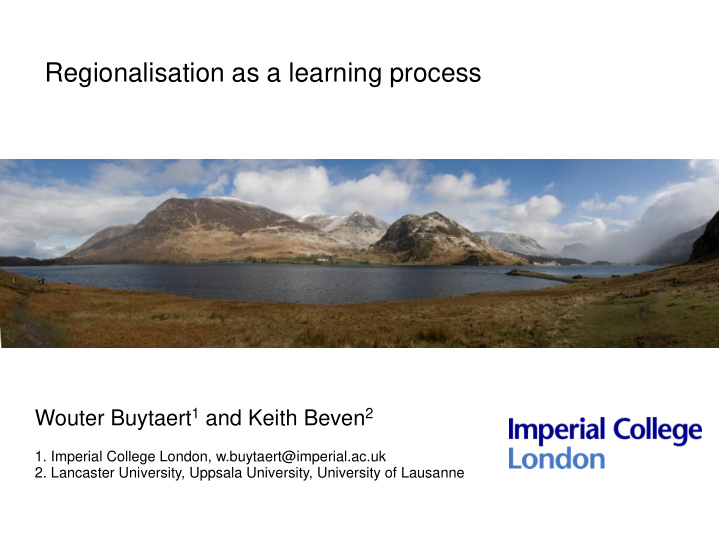



Regionalisation as a learning process Wouter Buytaert 1 and Keith Beven 2 1. Imperial College London, w.buytaert@imperial.ac.uk 2. Lancaster University, Uppsala University, University of Lausanne
Regionalisation Hydrological prediction is very often concerned with non-stationary conditions - changing land-use - changing boundary conditions (e.g., climate) - changing catchments (i.e. regionalisation) When making predictions in non-stationary conditions, we expect effective model parameters to change. Strategies for changing parameters in a regionalisation context - changing parameters by linking them to catchment properties - reconstitution of parameter sets from one or more donor catchments Here, we combine both approaches using within a learning framework: - Can parameter modifications improve the predictions of an ungauged basin in an ensemble approach? - If so, how much uncertainty is involved in this process? - Is it possible to characterize this uncertainty, and use it for future predictions?
Looking for uncertain parameter transformations... θ ' i = θ i + Δθ i sampling
The learning framework The learning process can be summarised as follows: - Derivation of parameter sets for one or more donor catchments with similar characteristics; - Construction of priors for the stochastic modifications needed for the predictor catchment; - Updating the parameter sets of the donor catchments with the modification to get prior parameters for the predictor catchment; - Evaluation and improvement of the modifications of step 2 when more information becomes available.
Case study: forestation in the Andes
Predicting proxy catchments (with uncertainty) 1. Prediction in similar conditions - generating prior parameter sets using GLUE - assessing prediction on precision and accuracy of prediction limits - no transformation Results: - average width of 2.5 10 – 5 mm/15 min, bracketing 83.8% of the observed discharge - accuracy lower than for the donor catchment (90%) so increased uncertainty
Predicting proxy catchments (with uncertainty) 2. Post-hoc evaluation of the parameter transformations
Predicting proxy catchments (with uncertainty) 3. Predicting the Effects of Land Use Changes - applying fuzzy linear transformations based on physical process understanding (deforestation, land use change) - changed parameter: vegetation coefficient for evapotranspiration (Kv): Increase (M): 0.43 Dispersion (D): 0.25 - change applied randomly to parameter sets
Forestation Cultivation (grey: without parameter transformation, dashed: with parameter transformation) => Possible to get accurate prediction limits using fuzzy linear parameter transformations
Conclusions As expected, even apparently similar catchments may require transformations of parameter sets to obtain predictions consistent with predefined prediction limits, resulting in broader prediction bounds. The major challenge of this approach is to choose an appropriate transformation model . This study explored the simplest case of linear independent dispersive shifts applied to the posterior parameter sets of the donor catchment. In one case, the required shift is consistent with literature values and therefore identifiable. In the other case, the simulations were less successful and a post hoc analysis suggested that an unrealistic change in parameters was necessary. The paper presents a general learning framework to analyse potential parameter transformations and to learn from parameter behaviour that allows the uncertainty in regionalisation to be analysed.
Recommend
More recommend